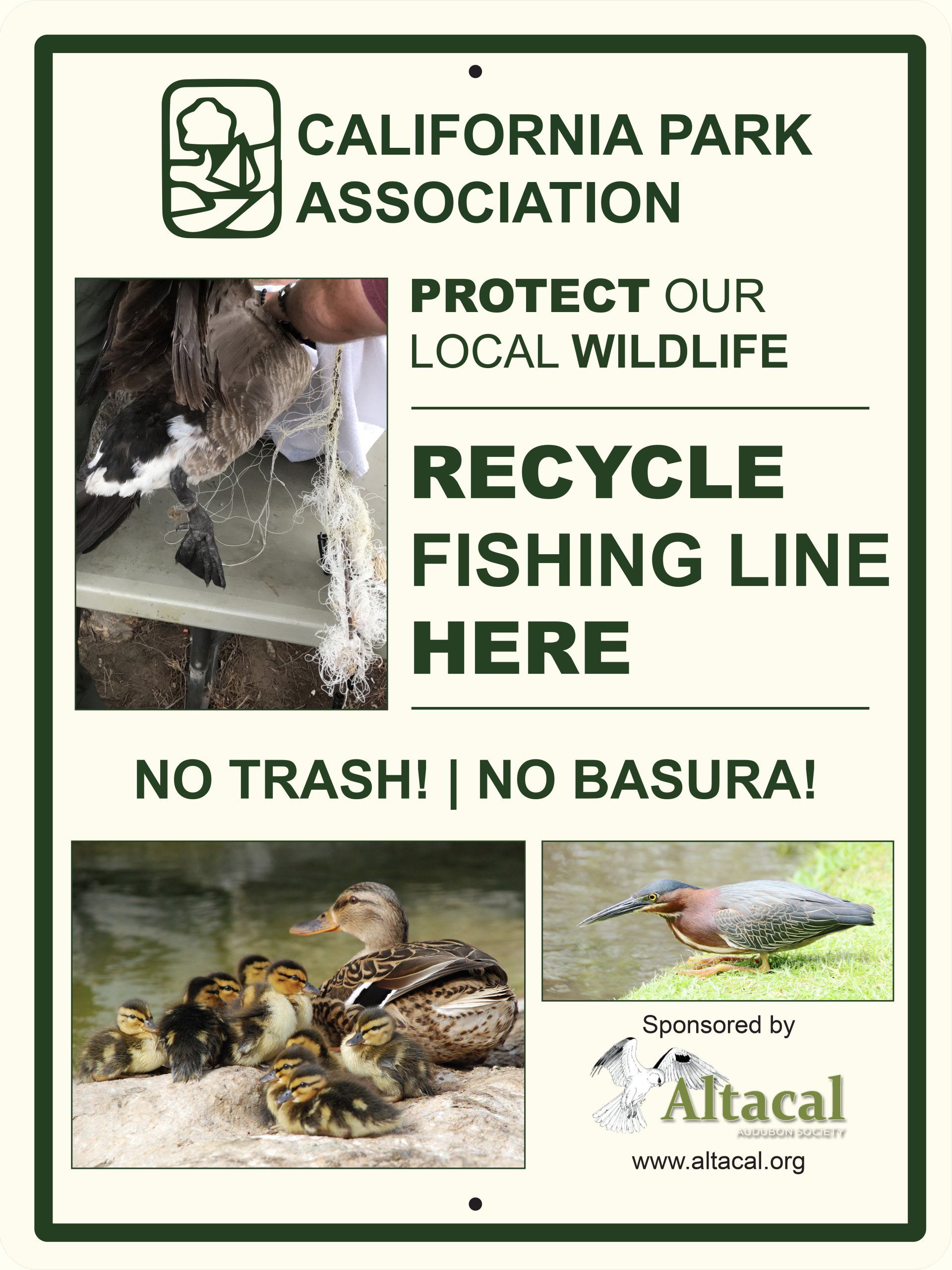Fishing Line Receptacle Signs
Read Chico News & Review Article: "Untangling a mess"
AltaCal has been involved with many conservation and research projects throughout the decades.
This research program was initiated by Dawn Garcia in 2005 as part of Project OwlNet. She ran the project until 2017 when Ken Sobon- a dedicated owl banding volunteer- stepped in to direct the program. Since 2005, they have banded 1,116 owls! Dawn documented the first 10 years of the project in a scientific paper which was published in the Spring 2017 issue of the Central Valley Bird Club Bulletin: “Fall Migration and Other Natural History Observations of the Northern Saw-whet Owl in Northern Interior California, 2005 – 2015”
Many valuable volunteers and hundreds of eager visitors have come up to BCCER to learn why and how we band owls, and will continue to do so under Ken’s direction.
"Floating Grebe Nests Receive Help from DWR."
Altacal received a grant administered by Audubon California and monetarily supported by the Luckenbach Council, the National Fish and Wildlife Foundation, and the National Oceanic and Atmospheric Administration to monitor the grebes on Thermalito Afterbay. Plumas Audubon Society worked under the same grant to monitor Lake Almanor, Eagle Lake, Lake Davis and Antelope Lake. Redbud Audubon Society monitored the grebes on Clear Lake. All three chapters monitored grebe production each year for ten years and also provided educational outreach for elementary schools and at festivals and other events.
Link to 2020 final monitoring report pdf.
Bank Swallows (Riparia riparia) are a threatened species in California due to their dependence on natural river processes. They are the smallest North American swallow, a fascinating species that burrows into the freshly-eroded banks of coastal bluffs and rivers in CA. 70-90% of the California population of bank swallows breeds on the Sacramento River. Most of our rivers have been “hardened” by rock or concrete-excluding swallows from nesting. Altacal is a member of the Bank Swallow Technical Advisory Committee (BANS-TAC), a diverse group of agency and nonprofit groups formed to educate people about bank swallows and provide recommendations when projects may impact swallow habitat. The BANS-TAC has recently published a Conservation Strategy for the species. Altacal was awarded a grant to develop a brochure informing landowners about bank swallows: Bank Swallows and Incentives for Landowners along the Sacramento River.
Altacal teams with many other agencies and organizations to help survey and monitor the Bank Swallow populations and their habitat on the Sacramento and Feather Rivers through the
Bank Swallow Technical Advisory Committee (BANS-TAC)
Our partners include the U.S. Fish & Wildlife Service, California Department of Fish & Wildlife, Department of Water Resources, Audubon California, River Partners, Point Blue, Sacramento River Conservation Area Forum, The Nature Conservancy, and the U.S. Army Corps of Engineers.
Tricolored blackbirds are a State Threatened species and have been declining in California. They are a highly nomadic species when choosing their nesting sites.
As a conservation tactic, a statewide survey is conducted triennially to determine the locations of the nesting colonies. If the colonies are found to be using agricultural crops as nesting substrate, the CDFW and Audubon can engage with the farmers to delay harvesting until nesting is completed, or they can sometimes purchase the crop from the farmer in order to save the colony. These surveys are conducted every three years on a statewide level and are important for the conservation of this species.
The breeding colonies can range in size from small numbers to over 100,000 nesting pairs! The nesting colonies are usually associated with freshwater emergent wetlands. The adults can travel quite a long distance to find food to bring back to their young, and they often forage together in large flocks.
In 2016 Ken Sobon worked with volunteers to build 17 owl nest boxes. 12 were installed at Big Chico Creek Ecological Reserve in 2017, and 5 on the Feather River Ranger District (Plumas National Forest). While we have not observed any Northern Saw-whet Owls using the boxes yet, we have documented a Western Screech-owl nesting in the same box, raising 12 young over 4 years (2017-2020). Ash-throated Flycatchers have also nested in these boxes and a Humboldt’s Flying Squirrel was found using one for shelter.

Fishing Line Receptacle Signs
Read Chico News & Review Article: "Untangling a mess"
AltaCal Audubon Society Inc. is a tax-exempt 501(c)3 nonprofit organization dedicated to promoting the awareness, appreciation, and protection of native birds and their habitats, through education, research, and environmental activities.